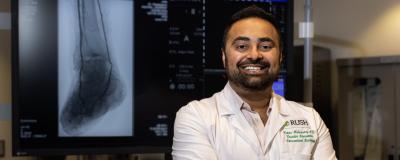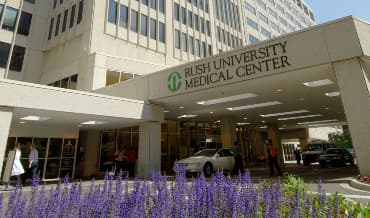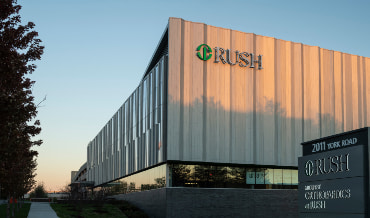The Rush Approach to Limb Preservation
If you are at risk of losing your limb, our limb preservation team is here for you with innovative, compassionate care. We do everything possible to help you keep your limb — even if you've been told amputation is your only alternative. Many patients come for second and third opinions to the Vascular Interventional Radiology Team from all around the Midwest to avoid major amputation.
Effectively treating limb-threatening health issues requires a coordinated approach, and that's the standard of care at Rush. Your care team may include physicians from many different specialties, such as vascular interventional radiology, podiatry, vascular medicine, plastic surgery, vascular surgery, infectious diseases and orthopedics, among others, to address all aspects of your limb preservation needs.
Rush is one of the nation's premier limb preservation treatment facilities, having served patients from the Chicago area, the Midwest and the whole country for nearly five decades. We’ve cared for thousands of patients of all ages, including those with the most difficult-to-treat conditions. And we've been a leader in research to improve limb-sparing technology. In fact, our limb-sparing endeavors have helped over 70% of our patients avoid major amputation, many as a second or third opinion.
Limb Preservation for Peripheral Artery Disease (PAD)
Symptoms of peripheral artery disease (PAD) are often resolved with rest and managed in the early stages with risk factor modification, such as diabetes control and therapy programs that can help you exercise and quit smoking.
Patients who progress with their symptoms may end up needing minimally invasive endovascular procedures or, potentially, open bypass surgeries to improve blood flow to the legs. Restoring the ability to walk without pain provides significant long term health benefits to patients.
Limb Preservation for Critical Limb Ischemia/Chronic Limb Threatening Ischemia (CLI/CLTI)
Patients in the late or end stage of PAD, known as CLI/CLTI, may be facing minor amputations within the foot or major amputations below or above the knee. Major amputations in these patients carry a very high mortality rate within five years — higher than many well-known cancers.
Patients often go through several angiograms or surgeries to improve blood flow. But arterial disease in patients with high calcium levels in the blood vessels, especially those with diabetes and kidney failure, is complex. Because of that, many are left with no options other than major amputation.
Some of the underlying causes of PAD also result in pruning of the arteries in the foot, referred to as “desert foot” or “no option” patients. This often makes the usual treatments to restore blood flow not possible or unsuccessful. But modern techniques like Deep Vein Arterialization, which is performed only at Rush and in certain facilities worldwide, have saved the limbs of patients who were otherwise facing major amputation.
Limb preservation requires early diagnosis and management, including reducing risk factors through diabetes control, quitting smoking, wound care and restoring blood flow, among other supportive treatments. Many patients can be prevented from undergoing major amputations.
Limb Preservation for Bone Cancer (Sarcoma)
Bone or soft tissue sarcoma can put limbs at risk for amputation. Our orthopedic oncologists specialize in limb-sparing procedures that focus on removing the tumor without amputation. U.S. News & World Report ranks Rush University Medical Center's orthopedics program and cancer program among the best in the nation.
You can learn more about these treatments from our Bone Cancer Care page.
Second Opinion Services for Limb Preservation at Rush
It can be scary to hear that your only option for treatment is amputation. Getting a second or even third opinion can be helpful for providing you with other choices for care or confirming that you and your doctor are making the best medical decision possible.
If you’d like a second opinion for limb preservation services, call (888) 352-7874. It’s best to have your previous diagnosis, test results and medical paperwork on hand, but we will work with you regardless to provide you with the best care available.
Rush Excellence in Limb Preservation
- State-of-the-art treatments: Our endovascular intervention specialists have increased the ability to preserve limbs with innovative techniques that are only offered in a few centers in the nation. These include access to alternative treatments, clinical trials and deep vein arterialization, among other approaches. Rush is also the first health center in Chicago to use the Esprit Below the Knee System, a procedure that uses a dissolvable stent that delivers medication to blocked arteries and restores blood flow to the foot, avoiding amputation. And we've been a leader in research to improve limb-sparing technology.
- Expertise in limb preservation: Our vascular interventional physicians are part of national and global trials for critical limb threatening ischemia (CLTI), have authored numerous articles on the topic and give global educational talks on this disease process.
- Tightly coordinated care: We know that when you're the patient, no treatment is routine. So, we strive to make the process as easy as possible for you by coordinating all aspects of your care — from pre-operative testing to obtaining all the equipment you may need after treatment, such as durable medical equipment, braces, crutches, orthotics or special shoes.
- Advanced treatment for complex wounds: To heal chronic wounds caused by complications of amputation, diabetes or other issues, we collaborate closely with wound care experts at our three main hospitals, including our comprehensive wound centers at Rush Copley Medical Center and Rush Oak Park Hospital. Because every patient's wound is unique, we'll develop an individualized plan of care for you, including diagnostic tests, treatments like hyperbaric oxygen therapy and weekly clinic visits for wound debridement. You'll also learn how to provide wound care at home and other steps to help you heal.





